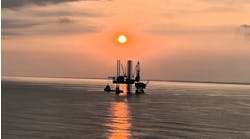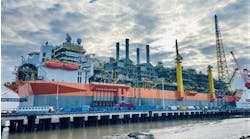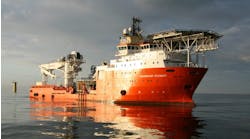Skarv well leaves questions
BP Norge's latest appraisal effort on Skarv in the Norwegian Sea may not have solved its development dilemma. Well 6507/5, drilled by the semisubmersible West Alpha, found oil in Jurassic sandstone at a test rate of 5,910 b/d. Early prognosis puts reserves past the previous 50-70 MMbbl band, but perhaps not high enough to justify BP's plan for a floating production, storage, and offloading (FPSO) vessel. The operator had hoped to file a development plan by the end of this year.
Prospects may hinge on other pending projects in the area (Belladonna, Ormen Lange), where the intention is to pipe gas in large volumes to the UK. Skarv itself has reserves of around 2 tcf. If a floater is sanctioned, Statoil's nearby Idun gasfield could be tied in, under a scheme that may call for around 20 subsea wells.
The Norwegian Petroleum Directorate (NPD) counted 12 new finds from exploration drilling on the Norwegian shelf last year. Four were in the Norwegian Sea, one in the Barents Sea, and seven in the North Sea - most of the latter lie close to production strongholds in the Tampen area. The largest gas find, classed at 5-10 bcm, came from Statoil's 7228/7-1 wildcat in the Nordkapp Basin in the Barents Sea. Statoil's M structure well 6506/11-7 in the Norwegian Sea was the largest liquids accumulation (63 MMbbl). Overall, however, the NPD rated the results a disappointment, adding a total of just 208-239 MMbbl of oil and 15-22 bcm of gas to Norway's reserves. This year, it predicts 25-30 new well spuds across the shelf, down from 33 in 2001.
Shell sanctions three projects
Shell and BP have gained government approval for the $244 million development of Madoes and Mirren in the Central North Sea. Effectively, this project is Eastern Trough Area Project (ETAP) Phase II - Phase I brought together numerous oil and gas accumulations in the mid-1990s that were considered marginal on a standalone basis. Both of the new fields will be developed through the Marnock central production platform via horizontal wells and multiphase/flow lines. This will add a total of 30,000 b/d of oil and 30 MMcf/d of gas to ETAP's current output of 140,000 b/d and 350 MMcf/d. Two other accessible accumulations, Fiddich and Wood, were part of an earlier Phase II plan, but have been put on hold pending ongoing technical assessment.
A couple of blocks to the southwest, Shell is tying Scoter, a 200 bcf find from 1989, back to its Shearwater high-pressure/high-temperature platform, via three subsea wells. The £78 million project also entails installation of a new production riser, allocation metering, and chemical injection/control system upgrades. Nearer to the Scottish mainland, in the Outer Moray Firth, Shell has submitted plans for a $406 million development of its Goldeneye gas-condensate field, based on a four-legged wellhead platform.
Baltic pipelines on hold
Denmark and Poland have pushed back plans for the BalticPipe gas project by a year. Earliest start-up date for the proposed new line is 2005, according to Danish state oil and gas concern DONG. The deferral is due to a recent downgrade of Poland's future gas needs.
DONG and its Polish counterpart POGC also are contemplating integrating this line, which will have capacity of 8 bcm, with the Baltic Gas Interconnector project to pipe gas from Denmark to Sweden and Germany. There is also a third potential Baltic gas line in the offing, which could take Norwegian supplies to Poland via southern Norway and Sweden. Possibly in anticipation, Statoil and Norsk Hydro have teamed up in a new venture, Naturgass Grenland, to explore possibilities for a regional gas market in the coastal towns south of Oslo. They put sales potential in this area at 20-30 MMcm/yr.
PGS moves in for Varg
PGS is the latest Norwegian contractor to try its luck as an operator. PGS will purchase Norsk Hydro's 42% controlling interest in North Sea production license 38, which includes the Varg Field, inherited from Saga. Other partners in the license are the State Direct Financial Interest with 30% and Statoil with 28%. Varg has underperformed in terms of reservoir producibility. PGS, which manages the FPSO on behalf of the licensees, sees this transaction as a way of extending the vessel's stay of duty, possibly moving on after a while to mop up other known accumulations in the area such as Rev.
Aker is partnering Germany's RWE-DEA in the first exploratory well for many years on the Agat gas field in the North Sea. Agat was discovered by Saga in 1980, but the license was relinquished a decade later. The well, in 225 meters water depth, is being drilled by the semisub Deepsea Bergen. The partners hope to prove up sufficient extra reserves to justify development.
Buzzard soaring
EnCana (formerly PanCanadian) has upped its estimate of reserves from the Buzzard oil discovery to over 400 MMbbl recoverable. Buzzard, the largest new find in the UK North Sea since Nelson in 1988, was discovered last summer in the central sector, 100 km northeast of Aberdeen. Drilling resumed in the fall, with the semisub Stena Don recently completing an appraisal well and sidetrack 3 km west of the original target. This program served to delineate the western edge of the accumulation's southern portion.
The Borgny Dolphin semi was then brought in for a well in a location 2 km north of the original discovery, and encountered a similar pay section. Early last month, drill-stem tests had been completed in two separate zones, with aggregate flow of 11,100 b/d of light oil through a 36/64-in. choke. A sidetrack was then planned. Two kilometers to the northwest, the Stena Dee has since spudded another well with a primary aim of identifying the oil/water contact in the field's central panel.
EnCana is nudging its partners BG, Intrepid, and Edinburgh Oil and Gas to move development forward. Genesis Oil and Gas has been working on two scenarios based on either two fixed platforms or an FPSO. Other untapped fields nearby could be brought into the selected scheme such as Enterpise's Ettrick.
Abandoned, but not forgotten
Two newly-formed independents, Tuscan Energy and Acorn Oil and Gas, won government sanction to reactivate the Argyll, Innes, and Duncan fields in UK Block 30/24. All were abandoned by Hamilton Oil & Gas in the early 1990s before their full potential had been tapped. The new team plans to extract at least 40 MMbbl of oil, probably using an FPSO.
The US combination of ATP and CalEnergy has been authorized to work on a "fallow" gas discovery in southern sector block 43/21a. The Agip-operated discovery well in 1992 tested 19.5 MMcf/d from Carboniferous and Rotliegendes sandstones.
Venture Petroleum, which secured operatorship of another Agip "discard," the Trees fields, has plans to develop Elm and Pine - now known collectively as Sycamore - through seven subsea wells drilled through a template. These would be tied back to Marathon's South Brae platform 15 km to the north.




